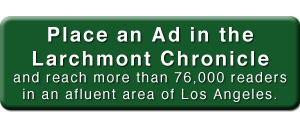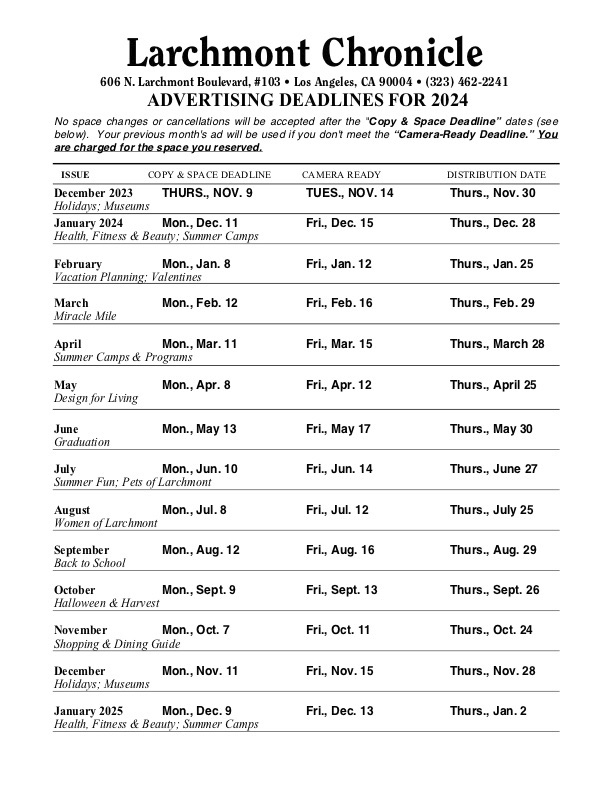Questions on Paramount plan loom large
Following the close of the Environmental Impact Report (EIR) comment period for Paramount’s Hollywood Project, some residents are left with more questions than answers.
“Paramount’s project includes building a parking structure next to the building I live in,” says Greg DeGraf, a Bronson Ave. resident.
DeGraf’s Larchmont Village apartment, where he has lived for the past three years, overlooks a parking lot on the south side of Melrose Ave. that is one of the proposed Paramount building sites. DeGraf is concerned about potential noise from construction 10 feet away from his window.
“When will construction begin? How many days a week will we be subjected to construction noise? How many hours a day?” These are all questions DeGraf has been asking city lawmakers. He has contacted Councilmen Mitch O’Farrell and David Ryu, but hasn’t yet heard back from either of them by the printing deadline of the Larchmont Chronicle.
Charles D’Atri, president of the Larchmont Village Neighborhood Association (LVNA), agrees that there are still a lot of unanswered questions.
“It’s indicative of my biggest complaint about this plan,” says D’Atri. “It now appears that Paramount is asking for every possible entitlement to see what they can get the city to give them.”
Gower St. parking
One of the unanswered questions relates to Paramount’s use of both Gower St. and Van Ness Ave. to park “base camp” production vehicles. According to Paramount’s online description of its Hollywood Project (available at paramounthollywoodproject.com), film and television production requires trucks and trailers to be adjacent to production whether it is taking place at the studio or on location.
If there is filming in the soundstages on the west side of the Paramount property, the studio might choose to obtain city permits to park a long column of trucks to serve the stages across the Gower St. sidewalk. This often has resulted in a temporary reduction of northbound traffic lanes on Gower from two lanes to one lane because of the width of the commercial vehicles.
Discussion at the LVNA semi-annual meeting on Nov. 17 (see page 11) included questions related to Paramount’s continued use of the lanes of adjacent public roads for base camp activities in lieu of using Paramount’s adjacent private property.
According to D’Atri, representatives from Paramount say the studio needs to keep all of its options open.
“While we are always adapting our parking plans to minimize off-site parking, we need to be flexible in the future to ensure that we can continue to accommodate productions as we build our Master Plan,” said Sharon Keyser, senior vice president, real estate, government and community relations for Paramount Pictures.
Keyser said, “One of the features of the Master Plan is to improve vehicle circulation on the lot. Because RKO and Paramount were separate properties originally, east-west internal circulation has always been challenging. The Master Plan focuses on improving circulation and also provides for base camp parking where modern, larger trucks can maneuver and park directly adjacent to soundstages.”
Billboards and sign district
Another issue of concern to LVNA residents, as well as some people citywide, is Paramount’s proposal concerning existing and new billboards and a requested “sign district” designation for the entire project.
The Draft EIR described the two, double-sided, off-site billboard signs currently located within the two parking lots on the south side of Melrose Ave. The EIR asserts that the city’s sign regulations would permit the replacement of the existing, double-sided off-site billboard signs with any permitted sign type, including digital display signs. That is not the case; it is only what Paramount is requesting.
These two existing billboards are on the south side of Melrose Ave. As such, they are within the LVNA area and the Greater Wilshire Neighborhood Council boundaries and City Council District 4 of David Ryu. The remainder of the vast Paramount project is in Councilmember Mitch O’Farrell’s Council District 13.
Karen Gilman, LVNA board member and secretary, said that “all neighborhoods are improved by the removal of ugly billboards. Removing and not replacing these two signs would be a great contribution by Paramount to Larchmont Village and the city as a whole.”
Dennis Hathaway, president of the Coalition To Ban Billboard Blight, observed that the vast Paramount project is similar to another one currently undergoing environmental review downtown. Of that project, Hathaway wrote that “the quest for a sign district could also run into difficulty, because the latest version of the citywide sign ordinance approved by the City Planning Commission in October limits sign districts to 21 geographic areas zoned for high-intensity commercial use.”
The areas surrounding Paramount, almost exclusively residential—plus a cemetery—are hardly scenes of high-intensity commercial uses.
The LVNA’s Gilman emphasizes: “The communities surrounding Paramount always have been primarily residential and still are, with the exception of a minor strip of commercial along Melrose plus Raleigh Studios. We do not need big super-graphics or billboards, digital or otherwise, to be in our midst.
“Paramount has always been a quiet enclave behind gates. Its only visibility has been its famous water tower, its entrance gates, and the lighted movie posters on two of its walls at Gower and Melrose. That should be all that remains in the future.”
Concludes D’Atri: “The more we talk about it, the more residents begin to recognize what a big project this is going to be for the neighborhood.”
By Billy Taylor
Category: News



